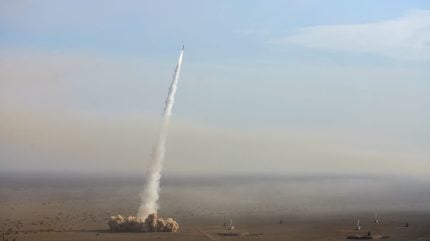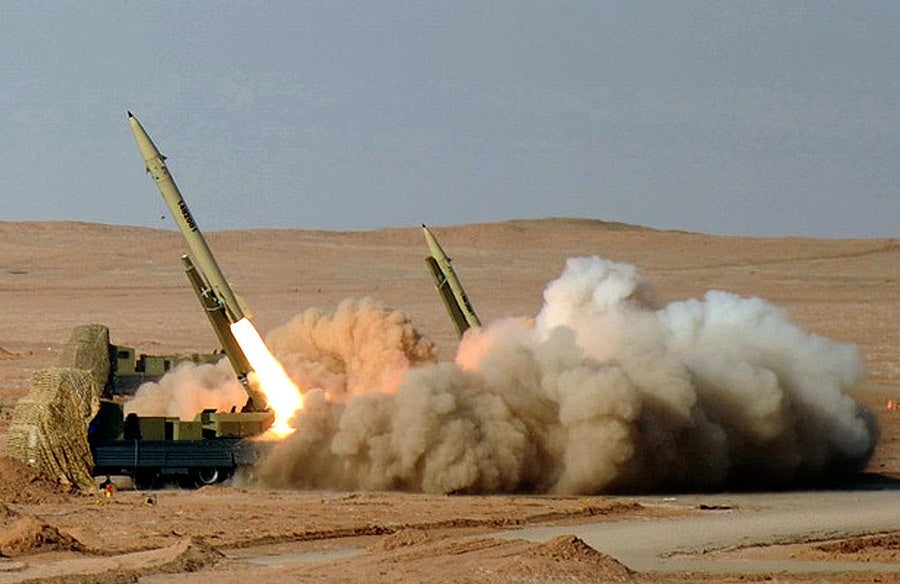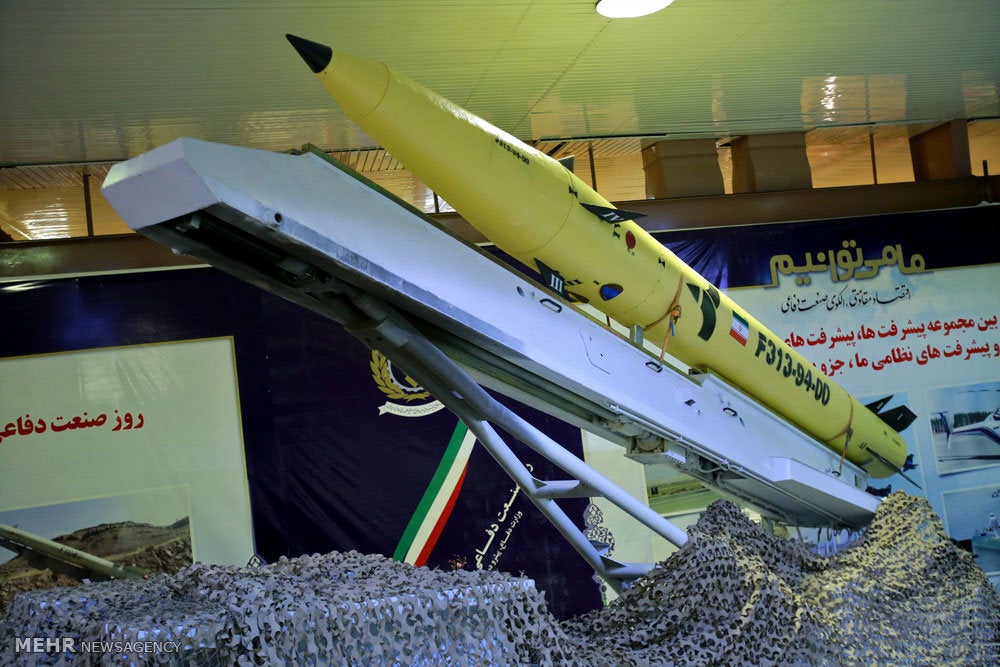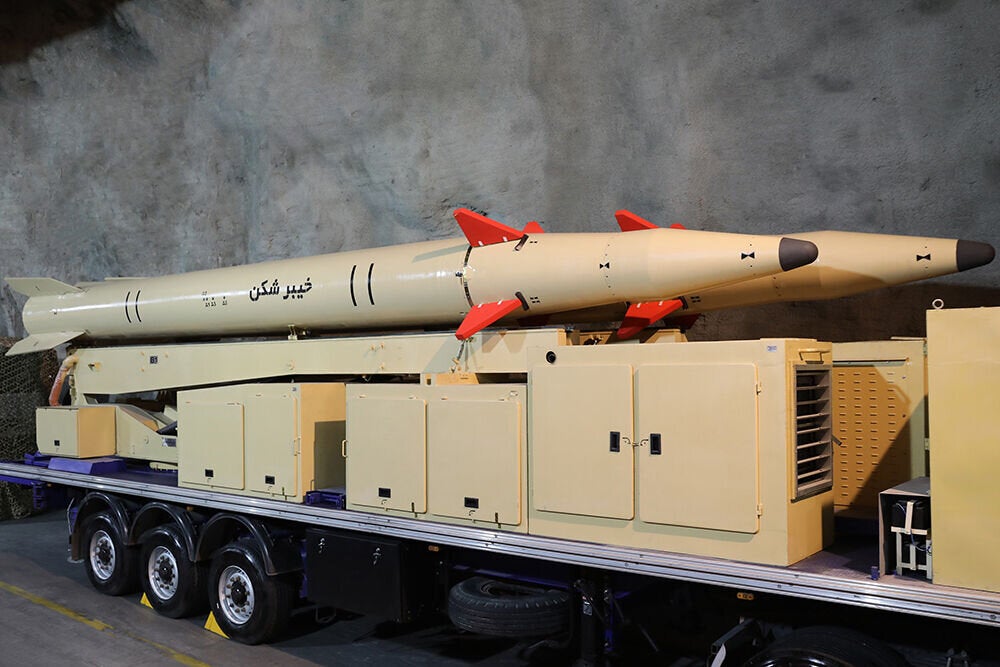
Iran has been actively developing both solid-fuel and liquid-fuel rockets as part of its ballistic missile programmes, dating back to the Iran-Iraq war in the 1980’s, with the Islamic Revolutionary Guard Corps (IRGC) playing a significant role in their development, viewing the missiles as a crucial deterrent against potential adversaries.
In retaliation for an Israeli air strike against an Iranian consulate in Damascus on 1 April 2024, Iran launched more than 330 standoff weapons against Israel on the 13 April, according to reports, including approximately 120 ballistic missiles.
In June 2025 Iran launched dozens of ballistic missiles against Israel in response to strikes against its energy and military infrastructure, with impacts registered in cities such as Tel Aviv and Haifa.
The IDF stated that between one-in-ten and one-in-twenty Iranian ballistic missiles typically evade Israel’s advanced air defence network, according to a report from The Jerusalem Post.
Iran has made steady progress in developing various classes of ballistic missiles, including Conventional Range Ballistic Missiles (CRBMs) that have a range of up to 300km, Short-Range Ballistic Missiles (SRBMs) with a range of 300km and 1000km, Medium-Range Ballistic Missiles (MRBMs) of range 1,000km to 3,000km, and with a route toward developing an Intermediate-Range Ballistic Missile (IRBM) that can reach between 3,000km and 5,500km.
The liquid-fuel rockets like the Shahab series have been part of Iran’s missile program for a longer period compared to some of the newer advancements in solid-fuel rocket technology, such as the Fateh-family missiles and solid-propellant motors for SLVs. Iran’s progress in both solid-fuel and liquid-fuel rockets demonstrates its commitment to advancing its missile capabilities across different propulsion systems.
Solid-fuel rockets employ a solid propellant, a pre-mixed and cast combination of fuel and oxidiser. This solid state offers easier storage and handling, as the propellant remains stable and ready for immediate use. Ignition with solid-fuel rockets is straightforward and quick, owing to the already combustible nature of the propellant. Once ignited, these rockets offer limited or no throttle control, restricting flexibility in adjusting thrust mid-flight. Despite this drawback, solid-fuel rockets are favoured for their reliability and lengthy shelf life.
Liquid-fuel rockets are characterised instead by their use of separate liquid components —fuel and oxidiser stored in different tanks. These elements are mixed and burned in a combustion chamber, a complex process with intricate plumbing and engine components. This complexity allows for better throttle control, and precise adjustments to thrust and trajectory during flight. Liquid-fuel rockets typically provide higher performance metrics, such as specific impulse and efficiency, compared to their solid counterparts.
The Fateh missile family
Iran possesses several Short-Range Ballistic Missiles (SRBMs) in its arsenal, designed for distances ranging from 300 to 1,000 kilometers. Among these SRBMs are solid fuel missiles of the Fateh series and its extended family, with high precision and road mobility.

Fateh-110 Series: The foundational model of this family, the Fateh-110, is a solid-propellant SRBM developed in the 1990s, with a range between 250km to 300km. Over time, Tehran has refined the Fateh-110 through multiple variants (A/B/C/D), enhancing range and precision to varying degrees. The missile saw combat use, notably against Kurdish targets in northern Iraq in 2018 and 2022, the latter in retaliation to an alleged Israeli assault.

Fateh-313: Unveiled in 2015, the Fateh-313 is an evolution of the Fateh-110, reportedly extending its range to about 500km through the use of a composite solid fuel and potentially lighter airframe. This missile played a role in the January 2020 attacks against US forces stationed in Iraq.
Zolfaghar: Introduced in 2016, the Zolfaghar pushes the boundaries further with a range of 700km and a separating warhead equipped with finlets for improved accuracy. The Zolfaghar has been battle-tested against ISIS forces in Syria and featured prominently in Iranian military exercises.
Fateh Mobin: Revealed in 2018, the Fateh Mobin is designed for versatility with an electro-optical seeker on its separating warhead. The missile is purported to have counter-electronic warfare capabilities. It is claimed to be an all-weather SRBM, despite the limitations of an electro-optical system inhibiting this capability. With only one reported test flight of the system, much is still unknown about its range and effectiveness.
Dezful: Tested in 2019, the Dezful is notable for its extended range of 1,000 kilometers, positioning it at the threshold between SRBMs and MRBMs. Its enhanced capabilities were demonstrated during the Great Prophet 15 military drills. While the payload weight is unknown, the Dezful’s warhead is longer than the Zulfiqar.
Ra’ad-500: Tested in 2020, the Ra’ad-500 has a shorter range than the Dezful and Zulfiqar, at just 500 kilometers. The road-mobile missile features a lighter airframe and a new composite motor that cuts around 1000kg from the weight of the original Fateh missile.
Zouhair: First displayed in 2022, little is known about the Zouhair, that seems to be a renamed and possibly redesigned Ra’ad-500, with changes intended to emphasise the use of composite materials to achieve a greater of range.
Shahid Haj Qassem: This missile, introduced in 2020, is the first MRBM from the Fateh family, with a range of 1,400km. It is reported to feature a separating warhead that can manoeuvre until it impacts a target.
Fath and Fath- 360: The Fath, first revealed in 2020, is a CRBM small enough to be compared to an artillery rocket, at half the size, diameter and weight of a Fateh-110 missile. It is also known as the BM-120, referencing its upper range of 120km. The Fath-360 was revealed and tested in September 2023, and it thought to have a range of 120km, and appears to be the same Fath missile that was introduced three years earlier.
BM-250: The BM-250 falls between the Fath CRBM and the Fateh-110 in terms of range and size.

Kheibar Shekan: The Kheibar Shekan, revealed in tested 2022, is a MRBM with a range of 1,450km. A report from the Foundation for Defence of Democracies refers to statements from Iran claiming that the missile has the range to target Israel. The report goes on to mention Brigadier General Ali Hajizadehm, a senior officer of the IRGC, and a reported claim that the missile has a significantly higher destructive capacity than its predecessors.
(Editor’s note: This article was updated from the original on 16 June 2025 to reflect renewed air and missile strikes between Israel and Iran)





